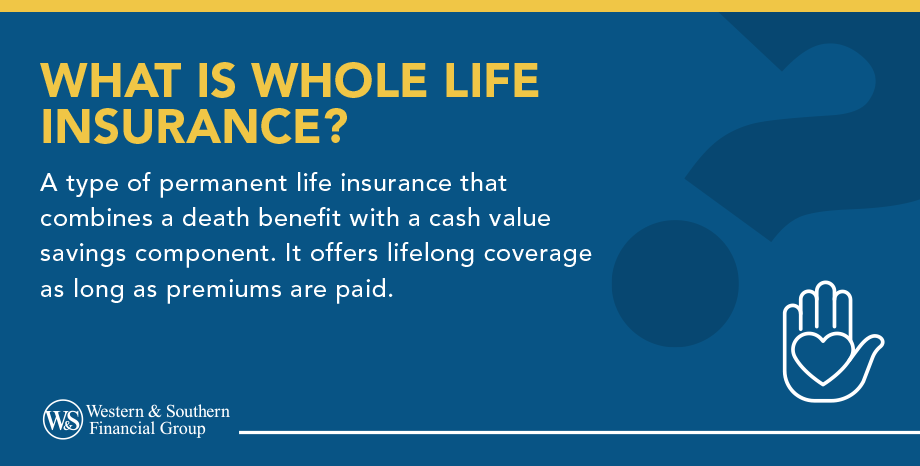Video Transcript
Today, we're going to explore whole life insurance. This is a type of permanent life insurance that covers you for your entire life. Unlike term life insurance, which covers you for a specific period, whole life insurance stays in effect as long as you pay the premiums.
When you pay your premiums, part of the money goes into a savings component known as the cash value. Over time this cash value may grow, usually at a guaranteed rate set by the insurance company. You can borrow against this cash value for things like education expenses, buying a home, or even retirement income.
One of the biggest advantages of whole life insurance is the financial security it offers. It provides a death benefit to your beneficiaries, which is the amount they receive when you pass away. Plus, the cash value growth is tax-deferred, meaning you don't pay taxes on it until you withdraw the funds.
Let's explore a few scenarios where whole life insurance can really come into play. For young families, securing a whole life insurance policy can help ensure financial stability regardless of life's unpredictability. It's comforting knowing that your family is protected financially, no matter what the future holds.
In estate planning, whole life insurance can be essential for preserving wealth and providing for loved ones, especially in covering estate taxes. This can be a strategic way to manage your legacy and ensure a smooth transfer of assets to the next generation.
For those looking to supplement their retirement income, the cash value of a whole life policy can be a valuable resource. It can serve as a supplementary income stream in your golden years, ensuring that you live comfortably without financial worry.
Whole life insurance is generally more expensive than term life insurance because it offers coverage for a lifetime and builds cash value. It's important to consider your financial situation and long-term goals. Think about why you're considering life insurance and how much coverage you might need.
If whole life insurance might be right for you, your next step is to reach out to a trusted insurance professional. They can help you understand the different policies available tailor one that fits your needs and budget.
Thanks for joining us today to learn about whole life insurance. It's about making sure that no matter what happens, you and your loved ones are financially secure.
Key Takeaways
- Whole life insurance is a permanent policy that provides lifelong coverage as long as premiums are paid.
- It includes a cash value component that grows at a guaranteed rate and can be borrowed or withdrawn over time. Taking withdrawals or loans will reduce the death benefit and should only be done in emergency situations.
- Premiums are typically fixed, offering predictable payments throughout the life of the policy.
- The policy pays a guaranteed, generally tax-free death benefit to your beneficiaries whenever you pass away.
- Some policies may pay dividends, which can be used to boost cash value, reduce premiums, or be taken as income.
What is Whole Life Insurance?
Whole life insurance is a permanent life insurance policy combining a death benefit with a cash value savings component. It offers lifelong coverage as long as premiums are paid. The savings component, known as "Cash Value," grows over time at a guaranteed rate and can be withdrawn or borrowed against by the policyholder.
Whole life insurance is a type of individual life insurance policy that provides:
- Lifelong coverage as long as you keep paying the premiums.
- A cash value that grows steadily over time.
Whole life insurance is important because it provides financial protection for your entire life, guaranteeing that beneficiaries receive the death benefit regardless of when the insured dies. Additionally, it offers a cash value component that grows over time. This combination of permanent coverage and cash value growth makes whole life insurance valuable for estate planning, wealth accumulation, and financial security for loved ones.
Whole life insurance is key for long-term financial security. Here's why:
- Provides lifelong coverage, ensuring beneficiaries receive a death benefit regardless of when you pass away.
- It accumulates cash value over time, which can be used for loans, withdrawals, or covering premiums.
This mix of lifelong protection and growing cash value makes whole life insurance a smart choice for planning your estate, building wealth, and ensuring your loved ones are cared for.
How Does Whole Life Insurance Work?
Whole life insurance is a type of permanent life insurance that combines lifelong coverage with a savings component known as cash value. Here's a detailed breakdown of how it works:
Premium Payments
When you purchase a whole life insurance policy, you agree to pay regular payments (monthly, quarterly, or annually). These premiums are generally fixed, meaning they remain the same throughout the policy's life.
Lifelong Coverage
The policy provides coverage for the insured's entire life as long as the premiums are paid. Upon the insured's death, the policy pays out a guaranteed death benefit to the beneficiaries, helping provide financial security for loved ones.
Cash Value Accumulation
Part of each premium payment is allocated to a cash value account, which grows over time at a guaranteed interest rate. The cash value grows tax-deferred, so you don't pay taxes on the gains as they accumulate.
Policy Dividends
Some whole life insurance policies, called participating policies, may pay dividends to policyholders. These dividends can be taken in cash, used to reduce premiums, or left to accumulate interest within the policy. Dividends are not guaranteed and depend on the insurer's financial performance.
Death Benefit
The primary purpose of a whole life insurance policy is to offer a death benefit to the beneficiaries upon the insured's death. The life insurance benefit is generally paid out tax-free and can be used by beneficiaries for various purposes, such as covering living expenses, paying off debts, or college tuition.
Living Benefits
Living benefit riders are add-ons to a whole life insurance policy that benefits a policyholder while they are still alive. These riders offer an added layer of financial protection by allowing policyholders to access funds during challenging times, such as when facing a severe illness. These conditions generally revolve around significant life events or health issues.
Paid Up Additions (PUAs)
A feature of whole life insurance policies enabling policyholders to use dividends or additional premium payments to purchase additional coverage. These additions increase the policy's cash value and death benefit, helping provide immediate financial growth and compounding over time.
Explore the benefits and coverage options of whole life insurance. Request a Free Life Insurance Quote
What Are the Types of Whole Life Insurance?
Whole life insurance comes in two main types: participating and non-participating.
Participating Whole Life Insurance
- Dividends: Policyholders receive dividends, which can be used to reduce premiums, purchase additional coverage (paid-up additions), or take them as cash.
- Cash Value: Potentially higher cash value growth due to dividends, depending on the insurer's financial performance.
- Flexibility: Offers more options for policyholders to utilize dividends to enhance their policy.
Non-Participating Whole Life Insurance
- Dividends: Do not pay dividends to policyholders.
- Cash Value: Cash value grows at a guaranteed rate without the potential boost from dividends.
- Stability: Generally offers a simpler, more predictable policy structure with guaranteed premiums and benefits.
Common Types of Whole Life Insurance
Pros: Benefits of Whole Life Insurance Policies
Whole life insurance policies offer several significant benefits, making them a valuable option for many individuals seeking insurance coverage and financial growth. Here are the key advantages:
- Lifelong Coverage: Whole life insurance covers the insured's entire lifetime, guaranteeing beneficiaries a death benefit whenever the insured passes, provided premiums are paid.
- Cash Value Accumulation: A portion of the premium payments goes into a cash value account, which grows at a guaranteed rate over time. This cash value can be used as a source of funds through loans or withdrawals.
- Fixed Premiums: Whole life insurance premiums are generally fixed, offering predictable costs for the policyholder.
- Guaranteed Death Benefit: The policy guarantees a specified death benefit paid out to the beneficiaries upon the insured's death, helping provide financial security for loved ones.
- Tax Advantages: The cash value grows tax-deferred, so you don't pay taxes on the gains as they accumulate. The death benefit is usually paid to beneficiaries tax-free.
- Policy Dividends: Certain whole life insurance policies may pay dividends based on the company's financial performance. Dividends can be taken in cash, used to reduce premiums, or left to earn interest within the policy.
- Loan Options: Policyholders can borrow against the policy's cash value, often at favorable interest rates. These loans bypass credit checks and feature flexible repayment options.
- Estate Strategy Support: Whole life insurance aids estate planning by covering estate taxes, helping provide for heirs, and ensuring smooth asset transfer.
- Stability and Security: Whole life insurance helps offers stable financial security with guaranteed cash value growth, market risk avoidance, and a guaranteed death benefit, making it a reliable part of a long-term financial future.


Cons: Drawbacks of Whole Life Insurance Policies
While whole life insurance policies offer several benefits, they also come with certain drawbacks that potential policyholders should consider. Here are some of the main disadvantages:
- Higher Premiums: Whole life insurance policies generally have higher premiums than term life insurance. The cost can be significantly higher, making it less affordable for some individuals.
- Complexity: These policies can be hard to understand due to the combination of life insurance and savings components. Policyholders need to understand the terms, conditions, and potential returns fully.
- Lower Initial Returns: The cash value component typically grows at a slower, guaranteed rate. The returns might be modest in the early years compared to other investment options, such as mutual funds or stocks.
- Cash Surrender Charges: If a policyholder decides to cancel the policy in the early years, they may face significant policy surrender charges, which can reduce the cash value received upon cancellation.
- Investment Risk in Certain Types: While traditional whole life insurance has guaranteed cash value growth, other types, like variable whole life insurance, involve investment risk. The cash value can vary depending on the performance of the underlying investments.
- Limited Flexibility: Whole life insurance policies generally offer less flexibility in adjusting the death benefit and premium payments than universal life insurance policies.
- Long-Term Commitment: Whole life insurance requires a long-term commitment to pay premiums. Failing to pay premiums can lead to the policy lapsing, resulting in a loss of coverage and possibly the cash value.
- Insurance Company Dependency: Dividend performance in participating policies depends on the life insurance company's financial health and performance. Dividends are not guaranteed and can vary.
Who Should Consider Whole Life Insurance?
Whole life insurance is a versatile financial product that offers lifelong coverage and a savings component. Here are the types of individuals who should consider whole life insurance coverage:
- Seeking Lifelong Coverage: Individuals who want to ensure their loved ones receive a death benefit regardless of when they pass away.
- Estate Planning Needs: Individuals with significant estates who want to ensure their heirs have the necessary funds to cover estate taxes and other expenses should consider whole life insurance. The death benefit can help provide liquidity to the estate, ensuring smooth asset transfer and reducing the financial burden on heirs.
- High-Net-Worth: Individuals with substantial assets may use whole life insurance as part of their wealth management strategy. High-net-worth individuals may find the tax-deferred cash value growth and tax-free death benefit appealing for wealth preservation and transfer.
- Business Owners: Business owners may find whole life insurance useful for various purposes, such as funding buy-sell agreements, ensuring business continuity, and helping provide key person insurance. The policy can also offer a source of funds through cash value loans, which can be used for business expenses or opportunities.
- Parents and Grandparents: Whole life insurance can help provide financial security for children or grandchildren. By purchasing a policy for a child or grandchild, the policyholder can provide lifelong coverage and accumulate cash value for future expenses such as education or home purchases.
- Seeking Stable Investment Options: Those who prefer conservative, stable investments with guaranteed returns may find whole life insurance appealing. The cash value grows at a guaranteed rate, helping provide a predictable, low-risk investment option.
- Fixed Premiums: Whole life insurance policies typically have fixed premiums, which do not increase over time. Individuals who want to avoid the uncertainty of rising premium costs should consider this type of policy.
How to Choose the Right Whole Life Insurance Policy
Choosing a whole life insurance policy requires careful consideration to meet your financial goals and needs. Here's a step-by-step guide to help you make an informed decision:
1. Assess Your Financial Goals and Needs: Determine the policy's primary purpose. Are you seeking lifelong coverage, a savings component, or both? Understanding your goals will help narrow down your options.
2. Calculate the Coverage Amount: Estimate the coverage you need to provide your beneficiaries. Consider factors like outstanding debts, future expenses (e.g., education, mortgage), and income replacement.
3. Evaluate Premium Affordability: Ensure you can afford the premium payments over the long term. Whole life insurance premiums are typically higher than term life premiums, so it's essential to budget accordingly.
4. Research Different Types of Whole Life Policies: Understand the different types of whole life insurance policies, such as traditional, universal, variable, and indexed universal life insurance. Each policy type has unique features and benefits.
5. Check the Insurer's Financial Strength: Select a reputable insurance company with strong financial ratings to ensure it can fulfill its obligations and pay the death benefit when needed.
6. Compare Policy Features: Look at the features of different policies, including:
- Cash Value Growth: Understand how the cash value accumulates and the interest rate applied.
- Dividends: Some policies pay dividends, which can be used to reduce premiums, increase cash value, or be taken in cash to supplement income in retirement.
- Loan Options: Check the terms for borrowing against the cash value, including interest rates and repayment conditions.
7. Optional Life Insurance Riders and Additional Benefits: Riders are optional features that can be added to the policy for an additional cost. Common optional riders include:
- Waiver of Premium: Waives premiums if you become disabled.
- Accidental Death Benefit: Provides an additional benefit if death occurs due to an accident.
- Long-Term Care Rider: Provides coverage for long-term care expenses.
8. Review the Policy's Flexibility: Assess the policy's flexibility regarding premium payments and death benefit adjustments, as some policies permit coverage changes to accommodate evolving needs.
9. Understand the Surrender Charges and Fees: If you decide to cancel the policy early, be aware of any surrender charges. Also, understand all fees associated with the policy, including administrative fees and management charges for investment-linked policies.
10. Consult an Advisor: Seek advice from a licensed insurance agent who can provide personalized recommendations for life insurance options based on your financial situation and goals.
How to Get Started
For more help understanding how to buy life insurance, planning your policy, or understanding those of your family members, consider reaching out to a financial representative for more information. They can explain these topics in more detail and help to ensure that your coverage will meet your needs.
Understand how whole life insurance can help provide your family's financial future. Request a Free Life Insurance Quote
Frequently Asked Questions
What’s the difference between term life insurance and whole life insurance?
Understanding the difference between term and whole life insurance is key to determining which coverage best suits your needs. Which is better depends on your circumstances.
- Premiums for term life policies are typically cheaper and suitable for those needing coverage for a limited time. In contrast, whole life insurance is pricier but provides lifetime coverage and a cash value component.
- Term policies are ideal for temporary financial obligations like mortgages or child-rearing expenses. In contrast, whole life policies are better for long-term financial planning and estate considerations.
Does a whole life policy expire?
No, a whole life policy does not expire as long as the premiums are paid. It is designed to provide lifelong coverage until the insured person's death. The policy will remain in effect, and the death benefit will be paid to the beneficiaries upon the insured's passing.
Can you convert a term policy to a whole life policy?
Yes, many term life insurance policies offer the option to convert to a whole life policy. This conversion allows you to extend your coverage from a fixed term to lifelong protection without needing a medical exam, and it includes benefits such as fixed premiums and a cash value component that may grow over time.
Before converting, consider your budget, financial situation, and long-term goals to determine if this option is right for you.
Footnotes
- Loans will accrue interest. Loans and withdrawals may generate an income tax liability, reduce the account value and the death benefit, and may cause the policy to lapse. There may be adverse tax implications for a policy classified as a modified endowment contract (MEC) or if the amount of your loans and/or partial surrenders exceeds the cost basis of the policy. Distributions including loans from an MEC are taxable to the extent of the gain in the policy and may also be subject to a 10% additional tax if the owner is under age 59½.




















